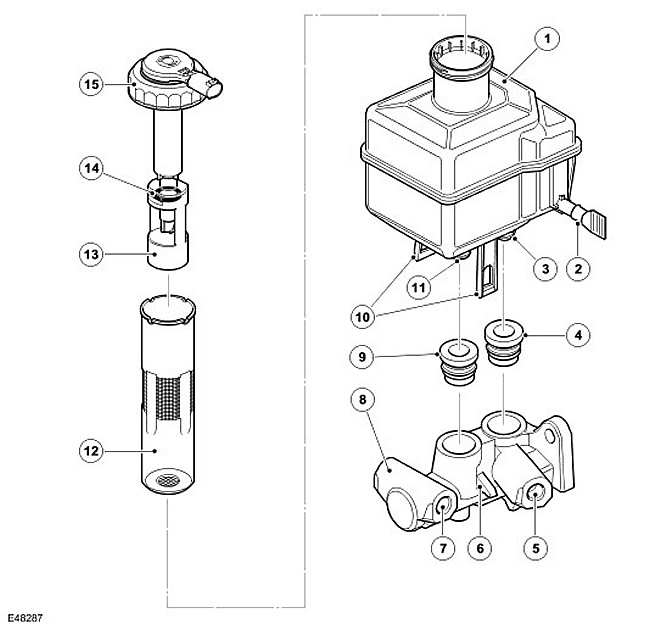NOTE: Right hand drive option shown; the left-hand drive variant has a similar design.

| Item name | Spare part number | Description |
| 1 | - | Tank |
| 2 | - | Clutch outlet fitting and sealing cap |
| 3 | - | Main outlet fitting |
| 4 | - | Tank main inlet seal for master cylinder connection |
| 5 | - | Main outlet |
| 6 | - | tank fixing pin |
| 7 | - | Auxiliary outlet |
| 8 | - | cylinder body |
| 9 | - | Auxiliary reservoir inlet seal for master cylinder connection |
| 10 | - | Tank straps |
| 11 | - | Auxiliary outlet fitting |
| 12 | - | Filter |
| 13 | - | Float |
| 14 | - | Magnet |
| 15 | - | Tank cap and liquid level sensor |
The brake master cylinder and reservoir are attached to the front of the brake booster on the driver's side in the engine compartment.
Master cylinder
The master brake cylinder consists of a cylinder body and two twin pistons. The rear piston pressurizes the main circuit and the front piston pressurizes the auxiliary circuit. The pistons have large capacity center valves providing sufficient fluid to the hydraulic control unit for stability.
When the brake pedal is depressed, the front brake booster rod moves the master piston along the bore in the cylinder body. This creates pressure in the main pressure chamber, which, together with the main spring, overcomes the resistance of the auxiliary spring and simultaneously moves the auxiliary piston in the hole. The initial movement of the pistons away from the travel stops causes the main and auxiliary center valves to close. Further movement of the pistons creates fluid pressure in the main and auxiliary pressure chambers and, consequently, in the circuits of the brake system. The fluid in the chambers behind the pistons is unaffected by the movement of the pistons and can flow without restriction through the feed holes in the chambers and reservoir.
When the brake pedal is released, the primary and secondary springs return the pistons to their lower position inside the cylinder body. When the pistons reach the travel stops, the main and auxiliary center valves open, allowing fluid to flow freely between the two hydraulic circuits and reservoir, through the center valves, chambers behind the pistons, and inlet ports in the cylinder body.
In the event of a malfunction in one of the brake circuits, the remaining brake circuit remains effective, but the brake pedal travel and braking distance of the vehicle increase.
Tank
The reservoir is installed on top of the master cylinder and provides the supply of brake fluid to the main and auxiliary circuits of the brake system. On manual transmission models, the reservoir also supplies brake fluid to actuate the clutch. For more information refer to Clutch Controls (308-02 Clutch Controls - 2.7L Diesel).
The two straps on the side of the reservoir engage the pins on the master cylinder to secure the reservoir. The two outlet fittings at the bottom of the reservoir fit into the master cylinder inlet seals. The outlet on the left side of the reservoir is for the hydraulic clutch circuit (in the presence of). On models with an automatic transmission, the clutch outlet fitting is closed with a sealing cap formed during the manufacture of the reservoir. This cap is removed only when installing the reservoir on models with a manual transmission.
The tank has internal baffles to separate the circuits when the liquid level is low, as well as to prevent leakage from one circuit in case of failure of the other circuit. Partitions support the central well and divide the space around it into eight compartments. The well is a continuation of the filler neck and contains a filter and a liquid level sensor.
The well and the compartments surrounding it are connected by slots in the partitions. The slots are arranged in such a way that, when the tank is full, liquid can flow between the well and all the chambers surrounding it, however, when the liquid level is low, the internal partitions form separate tanks for all circuits. The following figure shows the individual reservoirs for each circuit and the amount of brake fluid remaining in each reservoir in the event of a leak in one of the other circuits.
Comments on this article